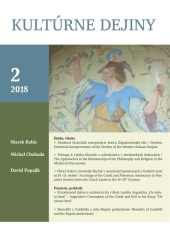Obraz české a moravské šlechty v narativních pramenech z českých zemí ze 14.–15. století
An Image of the Czech and Moravian Aristocracy in Narrative Sources from the Czech Lands in the 14–15th Century
Author(s): David PapajíkSubject(s): History, Local History / Microhistory, 13th to 14th Centuries, 15th Century
Published by: VERBUM - vydavateľstvo Katolíckej univerzity v Ružomberku
Keywords: aristocracy; lords; knights; narrative sources; 14th century; 15th century;
Summary/Abstract: In the text, the author analyses the change in how the authors of narrative sources from the Czech Lands in the 14–15th century perceived one of the prominent sectors of society – the aristocracy. He focuses on the traits of the nobility the chroniclers appreciated or, on the other hand, criticized. The author works with an extensive analysis of the most important extant narrative sources. A total of 16 chronicles were analysed, specifically The Chronicle of the Žďár Monastery (Cronica domus Sarensis, records from the period 1251–1300); The “Dalimil” Chronicle (describing the earliest times up until 1314), The Zbraslav Chronicle (Chronicon Aulae regiae, the chronicle maps the period between 1278–1338); The Chronicle of Francis of Prague (records from 1283–1353); The Chronicle of Beneš Krabice from Weitmile (records from 1283–1374); The Chronicle of Přibík Pulkava from Radenín (from the building of the Tower of Babel until 1330); The Neplach Chronicle (from the birth of Christ until 1360); Charles IV’s Curriculum Vitae (Vita Caroli imperatoris, the CV ends in 1346); a Report about John Hus in Konstanz written by Petr of Mladoňovice; a Narration about Jerome of Prague burnt in Konstanz in the name of Christ also written by Petr of Mladoňovice; a Very fine Chronicle of Jan Žižka, a companion of King Wenceslas IV; The Chronicle of Bartošek from Drahonice (records from 1419–1443); The Hussite Chronicle by Vavřinec of Březová (describes the period of 1419–1421 in great detail, with a short prologue from 1414 onwards); The Chronicle of Tábor written by Mikuláš Biskupec of Pelhřimov (describes the years 1419–1444); The Diary of a priest from Tábor on the negotiations of the Czechs on the Council of Basel (describes the years 1432–1433) and The Old Chronicles of Bohemia (records from 1378–1527).The aim of the study was to analyse the changes in the perception of one of the prominent sectors of society in the Czech Lands – the aristocracy – in narrative sources from the Czech lands in 14–15th century. It was the nobility along with the monarch who defined the course of the Czech Lands in the studied period. A total of 16 chronicles were analysed, specifically The Chronicle of the Žďár Monastery (Cronica domus Sarensis, records from the period 1251–1300); The “Dalimil” Chronicle (describing the earliest times up until 1314), The Zbraslav Chronicle (Chronicon Aulae regiae, the chronicle maps the period between 1278–1338); The Chronicle of Francis of Prague (records from 1283–1353); The Chronicle of Beneš Krabice from Weitmile (records from 1283–1374); The Chronicle of Přibík Pulkava from Radenín (from the building of the Tower of Babel until 1330); The Neplach Chronicle (from the birth of Christ until 1360); Charles IV’s Curriculum Vitae (Vita Caroli imperatoris, the CV ends in 1346); a Report about John Hus in Konstanz written by Petr of Mladoňovice; a Narration about Jerome of Prague burnt in Konstanz in the name of Christ also written by Petr of Mladoňovice; a Very fine Chronicle of Jan Žižka, a companion of King Wenceslas IV; The Chronicle of Bartošek from Drahonice (records from 1419–1443); The Hussite Chronicle by Vavřinec of Březová (describes the period of 1419–1421 in great detail, with a short prologue from 1414 onwards); The Chronicle of Tábor written by Mikuláš Biskupec of Pelhřimov (describes the years 1419–1444); The diary of a priest from Tábor on the negotiations of the Czechs on the Council of Basel (describes the years 1432–1433) and The Old Chronicles of Bohemia (records from 1378–1527).It was found that not all of the sources provide appropriate mentions relevant to the examined issue. No change in the perception of the examined social group over the course of the studied 200 years was determined. A decisive factor in evaluating the aristocracy in the chronicles was the social background of the chroniclers and their personal experience with the aristocracy. The positive traits of the nobility mentioned by authors dealing with the topic of the aristocracy in more detail were bravery and the ability to lead political affairs. In the chronicles, nevertheless, it was negative stereotypes that prevailed – laziness, parties, playing dice, tournaments, fondness of hunting, adultery, pride and vanity. The most forthright and positive treatise of the aristocracy was written by Jindřich Řezbář in The Žďár Chronicle – because the monastery was founded by nobles, which explains his praise of the dynasties of the founders and donators of the monastery, albeit with no direct collective mention of the aristocracy. In the Dalimil Chronicle, the author both praises the aristocracy as a social group with the right to dethrone an incompetent king, but also often criticises the nobility for their ill manners – fondness of hunting and hunting dogs, tournaments, debts, gluttony, drunkenness, carelessness in terms of honour, indifference towards political affairs and partiality towards the Germans. For the authors of The Zbraslav Chronicle (Petr Žitavský above all), the aristocracy was the root of all evil, disobeying laws, dissuading the king from proposing ideas for the betterment of the country (such as establishing a university in Prague, or drawing up a provincial code of law). Nobles were supposed to fight and not steal royal and clerical property; they were to ensure peace in their land. For The chroniclers of Zbraslav, members of the aristocracy represented, to a large extent, enemies disobeying the law, stealing, robbing and threatening stability on the land. For Petr Žitavský, the ideal situation was a strong monarch capable of maintaining the peace.
Journal: Kultúrne dejiny
- Issue Year: 9/2018
- Issue No: 2
- Page Range: 202-220
- Page Count: 19
- Language: Czech

